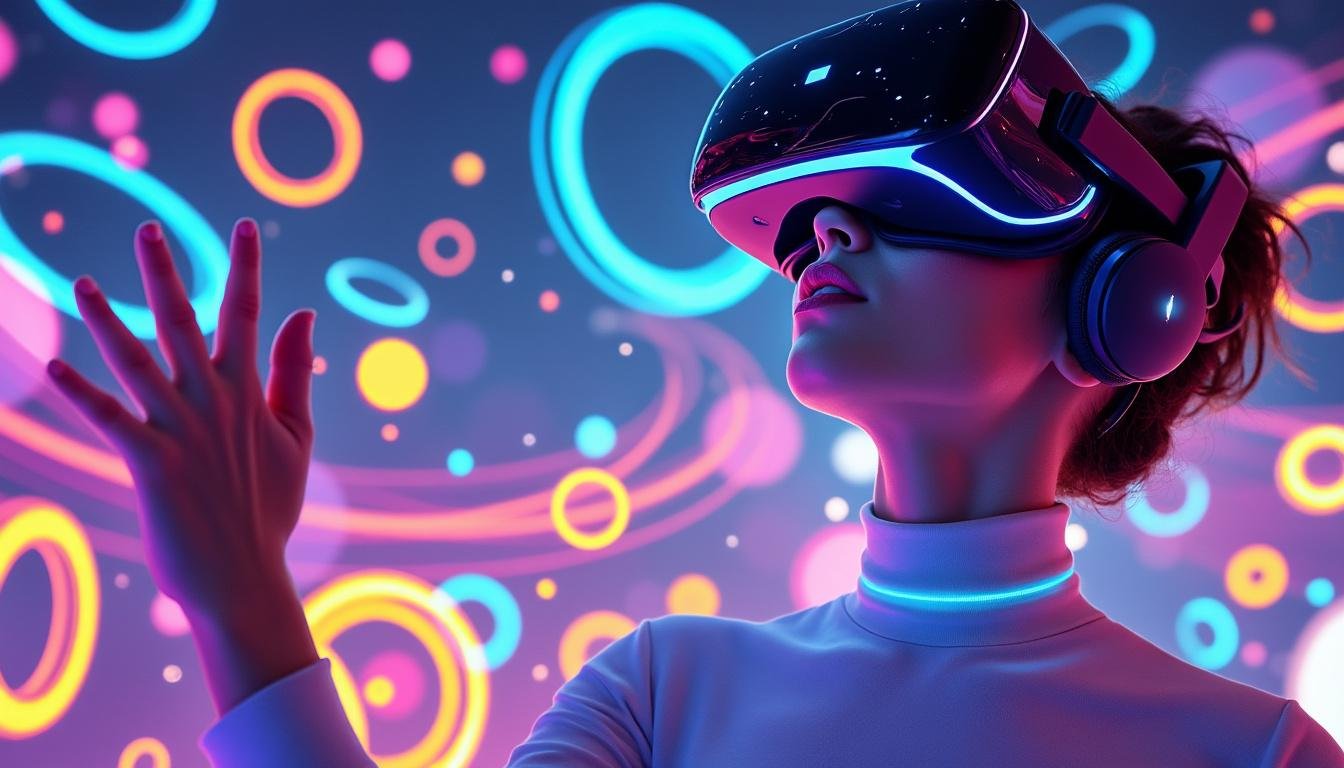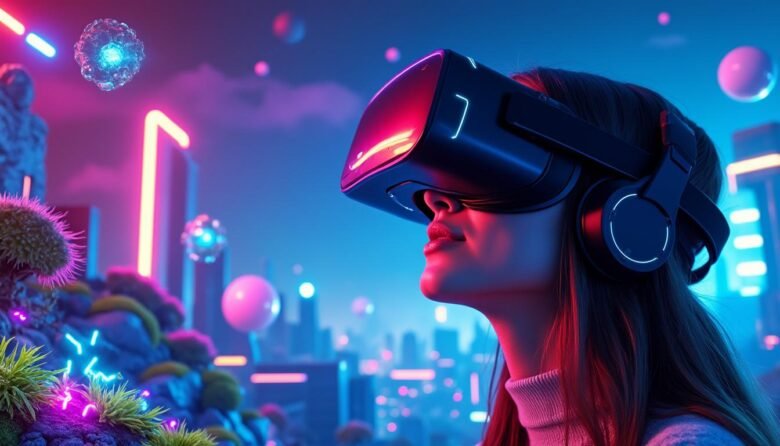En bref
- Virtual Reality (VR) creates immersive, three-dimensional environments by combining high-definition visuals, spatial audio, and precise motion tracking to foster a real sense of presence.
- By 2025, VR is expanding beyond gaming into training, education, healthcare, architecture, and therapy, with both standalone and PC-tethered options driving adoption.
- Key devices shaping the landscape include Meta Quest (formerly Oculus), HTC Vive, PlayStation VR (PS VR2), Valve Index, Pico Interactive, Varjo, and HP Reverb, among others.
- Despite growing accessibility, challenges like comfort, cost, and content diversity remain important considerations for new users.
- The year 2025 is paving the way for more social VR experiences and richer haptic feedback, blurring the lines between digital and physical realities.
Virtual Reality (VR) is a computer-generated simulation that creates immersive environments, allowing users to experience a sense of presence in real or imagined worlds. Through high-resolution visuals, spatial audio, and sometimes tactile feedback, VR convinces the brain that it is inside the simulation, delivering a lifelike, interactive experience. While initially popular in gaming, VR has grown into a versatile tool for training, education, and therapy, enabling practitioners and students to practice complex tasks in safe, controlled settings. In 2025, advancements in display tech, tracking accuracy, and device ergonomics are expanding the reach of VR to workplaces, classrooms, and clinics alike. The journey from headsets to holistic experiences is guided by core principles: natural head and body movement, believable depth cues, and responsive interactions that respect the user’s physical space. As the ecosystem matures, developers are crafting more accessible content and cross-platform experiences, inviting broader participation in these boundless realms.

Understanding the VR Landscape in 2025: Technologies, Devices, and Depth Perception
VR relies on a combination of hardware and software to deliver a convincing sense of presence. The core components include headsets with high-resolution displays, precise motion tracking, and sound that spatially anchors the user within the scene. Standalone systems offer freedom from wires, while PC-tethered and console-based setups push fidelity with more powerful processing. In 2025, the palette of devices continues to diversify, ranging from compact standalone headsets to enterprise-grade, high-resolution rigs. The depth perception that makes VR feel real is built on binocular disparity, motion parallax, and consistent head tracking, all synchronized with real-time rendering to maintain immersion. Below is a snapshot of representative devices shaping the market.
| Device | Type | Key Strengths | Notes |
|---|---|---|---|
| Meta Quest family (formerly Oculus) | Standalone / PC-tethered | All-in-one freedom, broad content library, inside-out tracking | Ideal for beginners and casual users; evolving ecosystem |
| HTC Vive (XR Elite, etc.) | PC-tethered / mixed options | High-fidelity visuals, robust room-scale tracking | Great for enthusiasts and enterprise setups |
| PlayStation VR (PS VR2) | Console (PS5) | Accessible living-room experience, strong exclusive titles | Seamless integration with Sony ecosystem |
| Valve Index | PC-tethered | Premium optics, precise tracking, high refresh rates | Best for enthusiasts seeking top-tier performance |
| Pico Interactive | Standalone / PC-tethered | Compact designs, competitive enterprise options | Growing international ecosystem |
| Varjo | Enterprise PC-tethered | Ultra-high resolution, advanced optics, strong analytics | Premium class for professional use |
| HP Reverb | PC-tethered | Very high-resolution displays, good for design workflows | Focused on professional applications |
In 2025, the landscape includes a mix of Oculus (Meta Quest) devices for portable VR, HTC Vive models for PC-powered performance, and PlayStation VR for couch-friendly experiences. Enterprise and research environments often rely on Varjo and HP Reverb for ultra-sharp visuals and precise tracking. For social and mass-market experiences, standalone options from Meta Quest and Pico offer accessible entry points, while Valve Index stands out for its fidelity and expansive tracking system. Regardless of the platform, the core goal remains the same: create a sense of presence that makes virtual environments feel real enough to interact with naturally.
Applications and Experiences: From Gaming to Training, Education, and Therapy
The immersive nature of VR makes it a versatile tool across several domains. In gaming, players engage with virtual worlds that respond to natural movements and gestures, elevating the sense of presence beyond traditional screens. In education and training, VR creates hands-on experiences that would be risky or impractical in real life, such as simulating surgical procedures or complex flight scenarios. Healthcare uses VR for therapy, rehabilitation, and exposure therapies, helping patients confront fears or practice motor skills in controlled settings. As content ecosystems expand, VR is increasingly used for architectural visualization, design review, and collaborative work in shared virtual spaces. The 2025 trend points toward social VR experiences, where teams and communities co-exist in persistent digital environments, as well as more accessible tools for creators to build immersive content.
- Gaming and entertainment: immersive, motion-controlled experiences that feel intuitive and responsive.
- Education and training: realistic simulations for hands-on learning without real-world risk.
- Healthcare and therapy: surgical rehearsals, pain management, and exposure therapies in safe environments.
- Aviation and industrial training: practice in emergency scenarios and complex procedures.
- Architecture and design: immersive walkthroughs and collaborative reviews of digital models.
| Application Area | Benefits | Representative Use Case |
|---|---|---|
| Gaming and Entertainment | Deeper immersion, natural interaction, social presence | Multiplayer VR adventures with coordinated teams |
| Education | Hands-on exploration of concepts, safe experimentation | Historical site reconstructions and interactive biology labs |
| Healthcare | Risk-free practice, enhanced planning, patient-specific simulations | Surgical rehearsal and rehabilitation therapies |
| Industry & Aviation | Efficient training, cost reduction, scalable scenarios | Emergency procedures in flight simulators |
Popular Headsets and Brands to Watch in 2025
For newcomers and veterans alike, the 2025 VR ecosystem centers on a mix of standalone headsets and PC-tethered rigs. Oculus devices—now branded under Meta Quest—continue to lower the entry barrier with portable, easy-to-use systems. Enthusiasts gravitate toward Valve Index for high-fidelity visuals and precise tracking, while HTC Vive remains a staple in professional and enthusiast circles. Console lovers can explore the latest PlayStation VR experiences, and enterprises often deploy Varjo or HP Reverb for work that demands the utmost visual clarity. The broad spectrum ensures there is a path for every user, from casual exploration to rigorous professional deployment.
- Oculus / Meta Quest — standalone, broad library, accessible budget
- HTC Vive — PC-tethered options, strong room-scale support
- PlayStation VR — console-friendly, strong exclusive titles
- Valve Index — premium PC VR, precise tracking
- Pico — standalone and PC-tethered models, growing ecosystem
- Varjo — enterprise-grade resolution and analytics
- HP Reverb — high-resolution PC VR for design and simulation
- Estimating Leonardo da Vinci’s IQ
- Exploring augmented reality and interactive experiences
- Different types of artificial intelligence
- AI in entertainment
- AI and robotics: Queen Elizabeth II’s legacy
- Essential steps for businesses to embrace AI
Resources and Further Reading
- Latest insights in AI: a curated collection
- Unveiling the Mona Lisa: original masterpiece
- Healthtech startups: trends and innovations
- The existence of humanity: are we truly here?
What is virtual reality, and how does it create a sense of presence?
Virtual reality is a computer-generated, immersive environment that uses visuals, sound, and motion tracking to make the brain feel as if you are inside the digital world. Depth cues like binocular disparity and motion parallax, combined with responsive head and body movements, generate a convincing sense of presence.
Do I need a powerful PC to enjoy VR?
Not always. Standalone headsets offer a convenient, cable-free experience with sufficient processing power built in, while PC-tethered setups maximize fidelity but require a capable computer. Your choice depends on your goals, budget, and tolerance for cables.
Which VR headset should a beginner try first?
For newcomers, a standalone system like Meta Quest provides an accessible entry point with a broad library. If you already have a gaming PC, a PC-tethered option like Valve Index or HP Reverb can deliver higher fidelity.
What are the main challenges facing VR in 2025?
Major considerations include comfort and ergonomics for long sessions, content availability and quality, price accessibility, and the need for safe physical space in shared environments.




